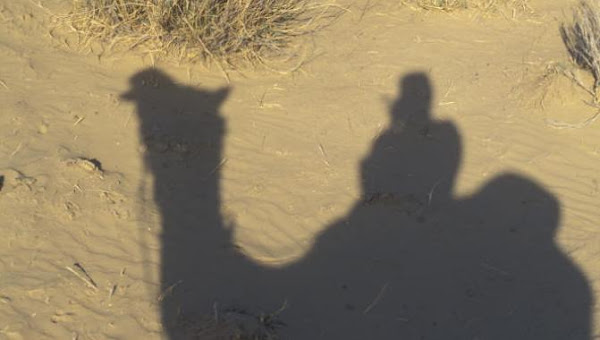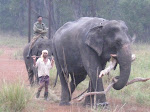Every Head is a World.'
- A Cuban proverb about the uniqueness of the individual.
`Man and the higher animals, especially the primates, have some few instincts in common. All have the same senses, intuitions, and sensations, similar passions, affections and emotions, even the complex ones such as jealousy, suspicion, emulation, gratitude and magnanimity;.... Charles Darwin, The Descent of Man `What happens to beasts will happen to man. All things are connected. If the great beasts are gone, man will surely die of a great loneliness of spirit.
-Chief Seattle of the Nez Perce, 1884.
"You see, the lantana bushes destroy the forest, that's why, ever so often they need to be cut down." Our forest guide Negi was at his awesome best, describing in detail the flora and fauna inside the Corbett National Park. A few months earlier a friend of mine was fascinated watching an elephant amble across the crowded streets of Mumbai. Six months later we were inside a wildflife park in North India, on the lookout for elephants in the wilderness of untamed forests.
Lying cosily and snug in the foothills of the Himalayas and named after the famous author and hunter turned conservationist, Jim Corbett; this wildlife park is one of the finest habitats of the Asian Elephant and tiger, besides having an impressive variety of flora, that includes Elephant grass, sal, khair (Acacia catechu), tendu (Diospyros tomentosa), canabis and sain (Terminalia tomentosa). Over 100 species of trees, 60 species of shrubs, 2 species of bamboos and over 30 species of climbers crowd the 520 sq. km. tract of forest with the winding Ramganga river acting as it's faithful companion.
It was early afternoon, the forest silent as we drove on unpaved roads in an open air jeep, with the wind gently brushing past our faces. All around, the forest began to unfold; here, a dense overgrowth of shrubs; there, a crowd of sal and bamboo; in the distance; elephant grass, while on the horizon it was irregularly-shaped mountain peaks reaching for the skies. The fresh forest and mountain air was beginning to intoxicate our senses.
I began asking Negi strange questions. "Do elephants talk?" Negi wasn't amused. Being specifically trained for his job, which is more of a rarity than a regularity in many wildlife parks, Negi proved to be an exception and stood out, like his pencil-thin moustache and his light eyes. "Elephants are known to communicate among herds for distances in the range of 20 kilometres using low-frequency calls that cannot be picked by the human ear," he replied. "Besides, elephants have immense intelligence and never forget until they die." A bit like humans, I thought. "Unlike other animals, the brains expand during their lifetime, thereby giving them a natural ability to learn, all the time." A bit unlike humans, I wearily concluded.
Negi's commentary was interrupted as we spotted the remains of a barking deer. Probably hunted down in the early hours of the morning by a famished tiger. Negi closely examined the pugmarks and concluded, that those marks belonged to a tigress. Somewhere in the distance she would be having her afternoon siesta, lying either in the rocky ravines or hidden in elephant grass. With 80 tigers roaming inside this wildlife park, the chances of tracking rest at about 10%. There is a greater chance of being spotted than spotting one. We moved on, Negi was more intent on speaking about elephants. The dense forest growth soon gave way to an open grassland, while the river snaked it's way through the plains. We spotted a lone tusker, quite unusual among elephants, as it's common for them to move in herds. Negi explained that periodically elephants suffered from a perplexing condition called `musth,' something which was associated with sexual maturity and desire and resulted in imbalanced mood behaviour.
During this period, they excrete a sticky substance from their temporal glands and are best left alone. From a distance the tusker looked in perfect composure. On closer inspection, he would be competing for Mr. Imperfect. We moved along.
"How do locals respond to wildlife conservation and poaching?" Negi replied, "the locals that live on the periphery of the forest are being asked to make contributions to wildlife preservation by becoming guides, more tourist friendly and discouraging attempts at poaching by turning down offers of killing wildlife, since it's the locals who possess immense knowledge about the forests and not the poachers, who generally provide only ammunition and money."
Sambhar gamboled in the running waters, oblivious of the dangers of the wild cats, while high above on a solitary branch, the crested serpent eagle surveyed the earth below for unsuspecting prey. The solitary King Vulture glided in open skies; at eye level, robins, bulbuls, drongos, woodpeckers and flycatchers could be heard and spotted along. With over 500 species of birds, we couldn't be grudged for sighting at least 100, though, we hadn't still managed to spot an elephant herd. The shadows began to lengthen with the sun commencing it's downward descent, casting a slanting orange glow and painting the forest, now awash with colors with crimson and gold. Negi continued his tidbits, like the one about elephants loving salt, to the number of toes on it's front and hind feet.
My mind raced back to the earlier occasions when I had spotted elephants in the wild at Madhumalai, Bandipur and Nagorhole National Parks in South India, herds that strode along crushing obstacles that came along their path. We watched from a distance in wonder and regaled at the marvels of Nature. Then there were the harvest festivals I had attended at the City Palace in Mysore, where on an auspicious day, I watched a huge procession of caparisoned elephants bedecked in jewellery and color.
This spectacle lasted for a few hours but left timeless memories. All of a sudden I asked Negi, whether elephants `bury' their dead ones? He said, "Yes, they do. Because they understand loss and mourn as well."
Light began to fade, the same could be said about the color on our faces. We craned our necks in all directions, looking for the elusive pachyderms. Negi had fallen silent, in fact the entire forest seemed to have retreated as well. All of a sudden, over a distance of over of a 1000 metres, I detected some movement. Against the backdrop of the dark impenetrable forest, it was impossible to tell. We stood and stared for what seemed like eternity, before we decided, yes it was indeed elephants. One couldn't mistake the slow deliberate movement of the group with different shapes and sizes, bodies donned the color of mud, instead of the customary black we are so used to seeing. We sped along.
Minutes later we found ourselves face to face with the herd, a large matriarchal group of about twenty, with oldest well in it's sixties, while the youngest was probably a year old, constantly getting lost among the pillar of legs, trunks and tusks. They foraged on grass and leaves and twigs and branches and continued the elephant procession, unmindful of our presence.
Led by a female in front and tuskers at the rear end, the group moved in two's and three's occasionally colliding with each other. We stared like curious schoolchildren on an outdoor picnic, vaguely trying to reconstruct the story of the elephant and six blind men. `Should an elephant attack you, spit at the end of his trunk,' someone once said. Leave alone spitting, I wondered whether I'd be able to open my mouth. Sure-footed, the group began it's retreat from the open grassland into the safe confines of the forest, from where we heard twigs being crushed and branches being broken, the occasional trumpet and swishing of trunks. It meant curtains for us as well, the `drama' of the pachyderms having lasted for a good wholesome ten minutes.
The species Elephas Maximus and me, what's the common thread that brings us together? Them, always showing up like duty-bound postmen and me behaving like a lover on his first unconfirmed date! Am I part of the herd as well? Search me. Perhaps Negi may have an answer.











No comments:
Post a Comment